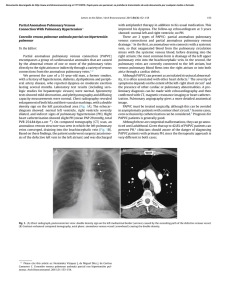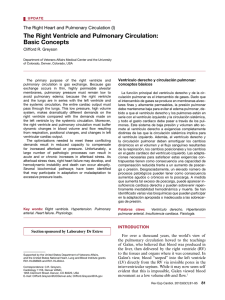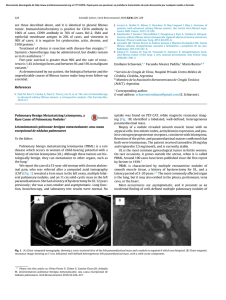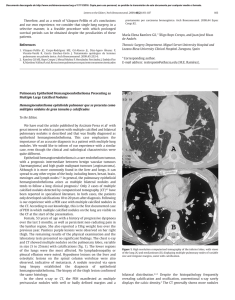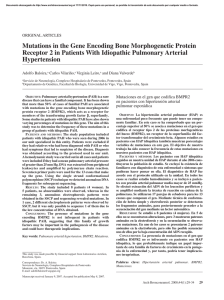Lung ventilation/perfusion scintigraphy in pulmonary
Anuncio
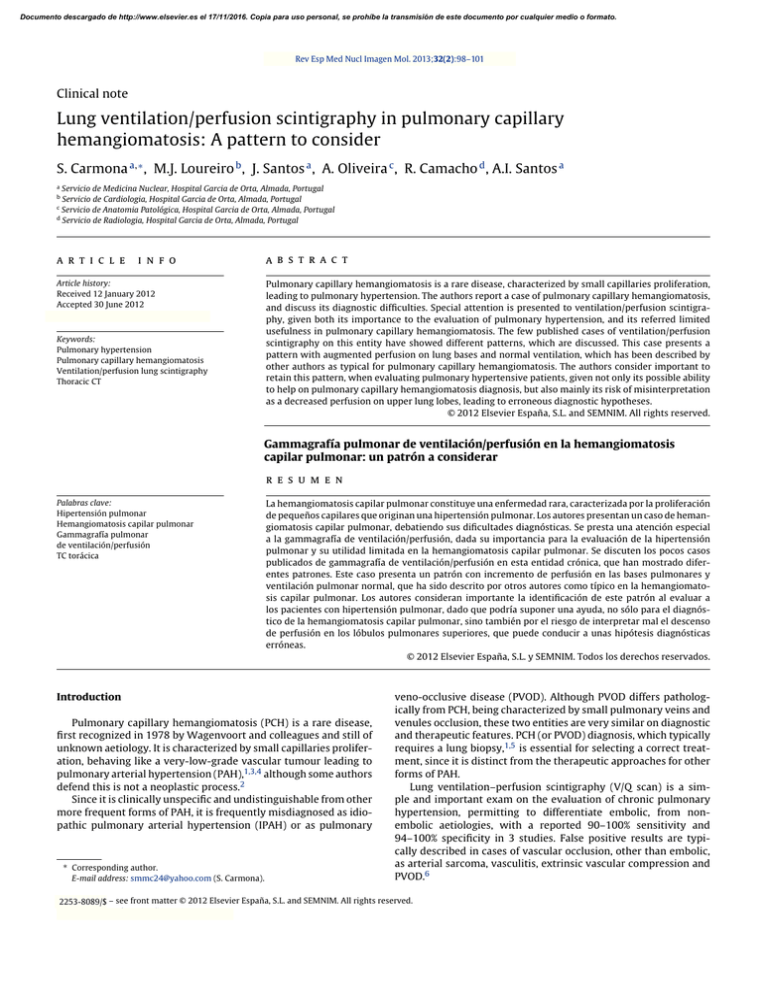
Documento descargado de http://www.elsevier.es el 17/11/2016. Copia para uso personal, se prohíbe la transmisión de este documento por cualquier medio o formato. Rev Esp Med Nucl Imagen Mol. 2013;32(2):98–101 Clinical note Lung ventilation/perfusion scintigraphy in pulmonary capillary hemangiomatosis: A pattern to consider S. Carmona a,∗ , M.J. Loureiro b , J. Santos a , A. Oliveira c , R. Camacho d , A.I. Santos a a Servicio de Medicina Nuclear, Hospital Garcia de Orta, Almada, Portugal Servicio de Cardiologia, Hospital Garcia de Orta, Almada, Portugal Servicio de Anatomia Patológica, Hospital Garcia de Orta, Almada, Portugal d Servicio de Radiologia, Hospital Garcia de Orta, Almada, Portugal b c a r t i c l e a b s t r a c t i n f o Article history: Received 12 January 2012 Accepted 30 June 2012 Available online xxx Pulmonary capillary hemangiomatosis is a rare disease, characterized by small capillaries proliferation, leading to pulmonary hypertension. The authors report a case of pulmonary capillary hemangiomatosis, and discuss its diagnostic difficulties. Special attention is presented to ventilation/perfusion scintigraphy, given both its importance to the evaluation of pulmonary hypertension, and its referred limited usefulness in pulmonary capillary hemangiomatosis. The few published cases of ventilation/perfusion scintigraphy on this entity have showed different patterns, which are discussed. This case presents a pattern with augmented perfusion on lung bases and normal ventilation, which has been described by other authors as typical for pulmonary capillary hemangiomatosis. The authors consider important to retain this pattern, when evaluating pulmonary hypertensive patients, given not only its possible ability to help on pulmonary capillary hemangiomatosis diagnosis, but also mainly its risk of misinterpretation as a decreased perfusion on upper lung lobes, leading to erroneous diagnostic hypotheses. © 2012 Elsevier España, S.L. and SEMNIM. All rights reserved. Keywords: Pulmonary hypertension Pulmonary capillary hemangiomatosis Ventilation/perfusion lung scintigraphy Thoracic CT Gammagrafía pulmonar de ventilación/perfusión en la hemangiomatosis capilar pulmonar: un patrón a considerar r e s u m e n Palabras clave: Hipertensión pulmonar Hemangiomatosis capilar pulmonar Gammagrafía pulmonar de ventilación/perfusión TC torácica La hemangiomatosis capilar pulmonar constituye una enfermedad rara, caracterizada por la proliferación de pequeños capilares que originan una hipertensión pulmonar. Los autores presentan un caso de hemangiomatosis capilar pulmonar, debatiendo sus dificultades diagnósticas. Se presta una atención especial a la gammagrafía de ventilación/perfusión, dada su importancia para la evaluación de la hipertensión pulmonar y su utilidad limitada en la hemangiomatosis capilar pulmonar. Se discuten los pocos casos publicados de gammagrafía de ventilación/perfusión en esta entidad crónica, que han mostrado diferentes patrones. Este caso presenta un patrón con incremento de perfusión en las bases pulmonares y ventilación pulmonar normal, que ha sido descrito por otros autores como típico en la hemangiomatosis capilar pulmonar. Los autores consideran importante la identificación de este patrón al evaluar a los pacientes con hipertensión pulmonar, dado que podría suponer una ayuda, no sólo para el diagnóstico de la hemangiomatosis capilar pulmonar, sino también por el riesgo de interpretar mal el descenso de perfusión en los lóbulos pulmonares superiores, que puede conducir a unas hipótesis diagnósticas erróneas. © 2012 Elsevier España, S.L. y SEMNIM. Todos los derechos reservados. Introduction Pulmonary capillary hemangiomatosis (PCH) is a rare disease, first recognized in 1978 by Wagenvoort and colleagues and still of unknown aetiology. It is characterized by small capillaries proliferation, behaving like a very-low-grade vascular tumour leading to pulmonary arterial hypertension (PAH),1,3,4 although some authors defend this is not a neoplastic process.2 Since it is clinically unspecific and undistinguishable from other more frequent forms of PAH, it is frequently misdiagnosed as idiopathic pulmonary arterial hypertension (IPAH) or as pulmonary ∗ Corresponding author. E-mail address: [email protected] (S. Carmona). veno-occlusive disease (PVOD). Although PVOD differs pathologically from PCH, being characterized by small pulmonary veins and venules occlusion, these two entities are very similar on diagnostic and therapeutic features. PCH (or PVOD) diagnosis, which typically requires a lung biopsy,1,5 is essential for selecting a correct treatment, since it is distinct from the therapeutic approaches for other forms of PAH. Lung ventilation–perfusion scintigraphy (V/Q scan) is a simple and important exam on the evaluation of chronic pulmonary hypertension, permitting to differentiate embolic, from nonembolic aetiologies, with a reported 90–100% sensitivity and 94–100% specificity in 3 studies. False positive results are typically described in cases of vascular occlusion, other than embolic, as arterial sarcoma, vasculitis, extrinsic vascular compression and PVOD.6 2253-654X/$ 2253-8089/$ – see front matter © 2012 Elsevier España, S.L. and SEMNIM. All rights reserved. http://dx.doi.org/10.1016/j.remn.2012.06.009 Documento descargado de http://www.elsevier.es el 17/11/2016. Copia para uso personal, se prohíbe la transmisión de este documento por cualquier medio o formato. 99 S. Carmona et al. / Rev Esp Med Nucl Imagen Mol. 2013;32(2):98–101 Anterior Posterior Right posterior oblique Left posterior oblique Left anterior oblique Right anterior oblique Fig. 1. Lung ventilation (upper row) and perfusion (lower row) scintigraphy show homogeneous ventilation in both lungs and augmented diffuse perfusion in both lung bases. Although there are few published cases of V/Q scan in PCH, different patterns have been described, from normal scans to ventilation and/or perfusion defects.1–4,7–10 Some authors report the existence of enhanced perfusion to the hemangiomatous tissue and argue the existence of a characteristic V/Q scan pattern in PCH,9,10 but false positive results for pulmonary embolism or parenchyma disease have also been reported in this entity.8 Case report A 47-year-old man was referred to our institution complaining of a 2 years progressive chronic cough, accompanied by exertional syncope for the latter 2 months, without other relevant symptoms. Electrocardiogram revealed sinus rhythm (75 beats/min), frontal plane QRS right axis deviation (96◦ ), P pulmonale (RA dilatation) and incomplete right bundle branch block (QRS – 100 ms). A transthoracic echocardiography showed a slight left ventricle hypertrophy with preserved function, paradoxical ventricular septum movement, left auricle and ventricle dilatation, right ventricle hypertrophy with systolic function commitment and PAH (systolic pulmonary arterial pressure = 90–95 mmHg) with slight tricuspid insufficiency. Chest radiograph demonstrated cardiac and pulmonary arteries enlargement and vascular attenuation on the periphery. On a first impression, the V/Q scan was evaluated as a diffuse homogeneous decreased perfusion primary in the upper lobes, with preserved ventilation. After careful research, the perfusion study was considered as augmented perfusion on the bases of both lungs (Fig. 1). Thoracic CT demonstrated a micronodular centrilobular pattern with ground glass opacities, more prominent on the lower twothirds of lungs, mediastinal lymphadenopathy and enlargement of the central and segmental pulmonary arteries (Fig. 2). The thoracic CT pattern was considered suspected of PCH or eventually hypersensitivity pneumonitis. Pulmonary function tests demonstrated reduced alveolocapillary diffusion. Right cardiac catheterization disclosed a right atrial pressure of 8 mmHg, pulmonary artery pressure of 101/43 mmHg (mean: 63 mmHg), pulmonary capillary wedge pressure of 8 mmHg, cardiac index of 1.49 L/min/m2 , pulmonary vascular resistance of 1692 dynes × s/m2 and trans-pulmonary pressure gradient of 55 mmHg. Lung biopsy revealed pulmonary focus of alveolar wall thickening, due to capillary proliferation, expanding around vessel walls and bronchioles, hyperplasia of tunica media of small arteries and arterioles, venules dilatation extending to subpleural space and intra-alveolar haemorrhage (Fig. 3). These findings were consistent with PCH. Discussion PCH is a rare and specific cause of PAH, characterized by diffuse capillary proliferation, in a vaguely lobular and patchy distribution, through the pulmonary interstitium and alveolar walls, also surrounding and invading small pulmonary vessels, small bronchi and the pleura.1,2,7,9 Its aetiology remains uncertain, although a myriad of associated conditions as systemic lupus erythematosus, scleroderma, Takayasu arteritis, Kartagener syndrome or hypertrophic cardiomyopathy have been reported. It is recognized to occur in congenital, familial and sporadic forms, this last one being the most frequent. The congenital form is usually associated with other development abnormalities and the familiar form is very rare, with an autosomal recessive inherence documented only in one family.1,3,7,10 A correct diagnosis is of extreme importance, since in addition to the fact that PCH has a specific treatment, distinct from other forms of PAH. PCH patients can have their state aggravated if a standard and not specific IPAH therapeutic is established.1,4 The new guidelines for the diagnosis and treatment of PAH, from the European Society of Cardiology and the European Respiratory Society, re-enforce the specificity of PCH and classify both PCH and PVOD on a separate subgroup within PAH, for its specific pathological, clinical and therapeutic issues.5 Fig. 2. Thoracic CT scan shows (A) a micronodular centrilobular pattern with ground glass opacities, feature more prominent on the lower two-thirds of both lungs (lung window); (B) enlargement of the central and segmental pulmonary arteries (mediastinal window) and (C) mediastinal lymphadenopathy (mediastinal window). Documento descargado de http://www.elsevier.es el 17/11/2016. Copia para uso personal, se prohíbe la transmisión de este documento por cualquier medio o formato. 100 S. Carmona et al. / Rev Esp Med Nucl Imagen Mol. 2013;32(2):98–101 Fig. 3. Histology of resected lung tissue. (A) On lower magnification, a patchy alveolar wall thickening with extensive capillary proliferation, and intra-alveolar haemorrhage can be seen (hematoxilin–eosin stain). (B) On higher magnification, proliferating capillary channels within the septa, surrounding pulmonary vessels and muscular hyperplasia on small arteries are better demonstrated with this vascular endothelial marker (CD31 immunohistochemical stain). Although the precise prevalence of PCH and PVOD is not known, they are thought to account for 5–10% of the forms of PAH initially considered idiopathic, with PCH being less prevalent than PVOD. We have found 63 published cases until September 2011. This research was based on MEDLINE database, using the key word pulmonary capillary hemangiomatosis; additional case reports were identified from the references of selected articles. Patients with PCH usually present with unspecific symptoms of progressive dyspnoea and fatigue, and are frequently misdiagnosed as IPAH. They may also have chronic cough, chest pain, syncope, digital clubbing, haemoptysis and haemorrhagic pleural effusion. These last two, when present, should raise suspicion of the possibility of PCH. As the disease progresses right sided heart failure and its symptoms appear and a median survival of 3 years from the initial presentation is expected.1,4,9 Electrocardiography typically demonstrates right axis deviation and right ventricular hypertrophy. Echocardiogram reveals PAH and excludes structural lesions and left ventricular dysfunction. Haemodynamic parameters present two distinct features: elevated pulmonary arterial pressure and normal or low pulmonary capillary wedge pressure. Chest radiograph demonstrates PAH (enlarged central pulmonary arteries and right sided prominence of the heart), and diffuse or bibasilar reticulonodular or micronodular areas of opacity; mediastinal lymphadenopathy may be reported. Chest CT shows pulmonary arterial enlargement and widespread centrilobular nodules, mixed with lobular ground-glass opacities; sporadically, septal thickening, lymphadenopathy, pleural effusion, enlargement of right heart chambers and pericardial effusion are seen.1,4,10 As advocated by this case, presently it is accepted that combining clinical suspicion and radiological findings, namely a high resolution CT, the diagnosis of PCH or PVOD can be established with almost certainty.1,5 This is an important feature since lung biopsies must be made with extreme care in these patients, especially in people with elevated PAH, due to the elevated risk of complications. More difficult is to differentiate PCH and PVOD, usually only provided by pathological examination.1 Although few cases of V/Q scan on PCH have been published, this exam is usually considered of no use in the diagnosis of PCH since several patterns have been described, such as diffuse augmented perfusion on the bases, perfusion defects with preserved ventilation, matched ventilation and perfusion defects, ventilation defects with normal perfusion and even normal exams.1–4,7–10 Augmented perfusion on the pulmonary bases is described by some authors as a typical pattern of PCH, since, in this condition, these are the regions of lung most affected by proliferating capillaries, as documented in our case. These authors defend that this pattern can help to distinguish PCH from other forms of PAH.10 In perfusion mismatched defects, two different patterns were described: diffuse defects in the upper lobes or focal defects. The former, when we look retrospectively, can in fact correspond to the pattern of augmented perfusion on the bases that gives the erroneous perception of decreased perfusion on upper lobes, as in our case.8 The focal defects mimic thromboembolism and can be attributed to the development of in situ thrombosis, as it has been reported in some autopsies, or small vessels compression by proliferating capillaries, that has also been described in PCH.2,7,8 Perhaps the normal, augmented perfusion on bases and mismatched perfusion defects represent different phases of the disease or even different physiopathologic expressions of PCH. Ventilation defects with normal perfusion or perfusion and ventilation matched defects have been also described in this pathology, and although in some patients no concomitant disease was found in the lungs, perhaps this pattern was caused by other condition than PCH.2,4,9,10 Although the role of V/Q scan on PCH seems to be limited, among all the V/Q scan patterns reported, the authors consider the one of augmented perfusion on the lung bases emerge as a relevant one. In fact this pattern seems to help on the diagnosis of PCH, as supported by our case and other authors,10 but can be misinterpreted as decreased perfusion on the upper lobes, leading to erroneous diagnostic hypotheses. Therefore, the authors conclude that awareness of this pattern is important, especially considering that, although PCH is a rare condition, the elevated number of V/Q scans performed on PAH patients, increases the possibility of coming across it. References 1. Frazier AA, Franks TJ, Mohammed TH, Ozbudak IH, Galvin JR. Pulmonary venoocclusive disease and pulmonary capillary hemangiomatosis. Radiographics. 2007;27:867–82. 2. Gimeno RB, González-Carreró J, Iglesias B, Vicente C, Durán MLT. Pulmonary capillary hemangiomatosis: a rare cause of pulmonary hypertension. Arch Bronconeumol. 2002;38:291–4 [article in Spanish]. 3. Pycock CJ, Thomas AJ, Marshall AJ, Scarratt W. Capillary haemangiomatosis: a rare cause of pulmonary hypertension. Respir Med. 1994;88: 153–5. 4. Almagro P, Julià J, Sanjaume M, González G, Casalots J, Heredia JL, et al. Pulmonary capillary hemangiomatosis associated with primary pulmonary hypertension. Medicine (Baltimore). 2002;81:417–24. 5. Galiè N, Hoeper MM, Humbert M, Torbicki A, Vachiery JL, Barbera JA, et al. Guidelines for the diagnosis and treatment of pulmonary hypertension: the Task Force for the Diagnosis and Treatment of Pulmonary Hypertension of the Documento descargado de http://www.elsevier.es el 17/11/2016. Copia para uso personal, se prohíbe la transmisión de este documento por cualquier medio o formato. S. Carmona et al. / Rev Esp Med Nucl Imagen Mol. 2013;32(2):98–101 European Society of Cardiology (ESC) and the European Respiratory Society (ERS), endorsed by the International Society of Heart and Lung Transplantation (ISHLT). Eur Heart J. 2009;30:2493–537. 6. Barst RJ, McGoon M, Torbicki A, Sitbon O, Krowka MJ, Olschewski H, et al. Diagnosis and differential assessment of pulmonary arterial hypertension. J Am Coll Cardiol. 2004;43 Suppl. S:40S–7S. 7. Langleben D, Heneghan JM, Batten AP, Wang NS, Fitch N, Schlesinger RD, et al. Familial pulmonary capillary hemangiomatosis resulting in primary pulmonary hypertension. Ann Intern Med. 1998;109:106–9. 101 8. Rush C, Langleben D, Schlesinger RD, Stern J, Wang NS, Lamoureux E, et al. Lung scintigraphy in pulmonary capillary hemangiomatosis. A rare disorder causing primary pulmonary hypertension. Clin Nucl Med. 1991;16:913–7. 9. Lippert JL, White CS, Cameron EW, Sun CC, Liang X, Rubin LJ, et al. Pulmonary capillary hemangiomatosis: radiographic appearance. J Thorac Imaging. 1998;13:49–51. 10. Gugnani MK, Pierson C, Vanderheide R, Girgis RE. Pulmonary edema complicating prostacyclin therapy in pulmonary hypertension associated with scleroderma. Arthritis Rheum. 2000;43:699–703.
